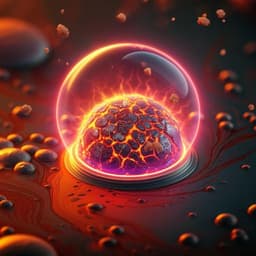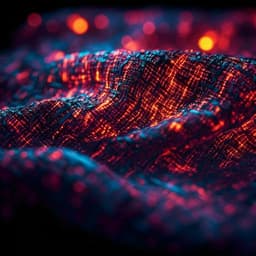
Engineering and Technology
Smart coating with dual-pH sensitive, inhibitor-loaded nanofibers for corrosion protection
C. Li, X. Guo, et al.
Discover how innovative smart coatings created by Chao Li, Xiaolei Guo, and Gerald S Frankel offer on-demand corrosion protection using advanced inhibitor-loaded nanofibers. These remarkable nanofibers not only enhance corrosion resistance but also adaptively release corrosion inhibitors when needed, ensuring lasting protection even under duress.
Playback language: English
Introduction
Aluminum alloys, such as AA2024-T3, are vital in aerospace due to their strength and lightness but suffer from localized corrosion due to microgalvanic coupling between intermetallic particles and the aluminum matrix. Coatings containing corrosion inhibitors offer protection, with pigments like strontium chromate, lithium carbonate, and cerium cinnamate used effectively. However, these inhibitors can negatively impact the coating's barrier properties and leach quickly. Micro- and nanocapsules help address this by isolating inhibitors, but they present challenges, including undermining coating integrity, creating stress concentrations, and leading to heterogeneous inhibitor distribution, limiting protection efficacy. An alternative involves using nanofibers, which offer improved mechanical properties due to interfibrous pores, enabling interaction with the coating matrix. Their submicron diameter allows incorporation into thin coatings, and their continuous structure facilitates inhibitor transport to damaged areas for long-term healing. While previous studies showed nanofibers' repeated corrosion suppression, the release was triggered by external mechanical forces, whereas local pH changes during corrosion offer a more relevant stimulus. pH-sensitive nanofibers can release inhibitors in response to pH shifts, while retaining them when corrosion is reduced. However, most existing nanofibers are not stimulus-responsive or only react to water penetration. While some prior research explored pH-sensitive inhibitor-loaded nanofibers, many only responded to either acidic or alkaline conditions. Even dual-pH sensitivity has been limited due to discontinuous fiber length and absence of a nanofiber network. This study aimed to overcome these limitations by using the coaxial electrospinning technique to encapsulate Ce(NO₃)₃, a mixed inhibitor, into nanofibers with a chitosan/PAA polyelectrolyte coacervate shell. The chitosan/PAA coacervate is selected because of its potential dual-pH sensitivity and suitability for electrospinning. Ce(NO₃)₃ is chosen for its corrosion inhibition efficacy, its mixed inhibitor nature (inhibiting both anodic and cathodic reactions), and low toxicity compared to hexavalent chromium. The research involved characterization of the nanofibers, study of their release behavior, development of a pH-sensitive coating using the nanofibers within a polyvinyl butyral (PVB) matrix, and comprehensive electrochemical testing of corrosion resistance and self-healing capability.
Literature Review
The literature extensively covers the use of corrosion inhibitors in coatings to protect aluminum alloys. Traditional methods using pigments like chromates have been effective but face environmental concerns. Microencapsulation and nanocontainers have emerged as strategies to improve inhibitor release control, but their limitations include the potential for defects in coating integrity and uneven distribution of inhibitors. The use of nanofibers as delivery systems for corrosion inhibitors has gained attention due to their ability to create interlocks with the coating matrix and facilitate transport of inhibitors to damaged areas. However, a significant gap in the literature was the lack of dual-pH responsive nanofibers capable of consistently releasing inhibitors in response to both acidic and alkaline conditions generated during corrosion. While some previous studies showed pH-sensitive nanofibers or dual pH-responsive materials, they lacked the continuous structure and interconnected network necessary for effective self-healing. The use of a chitosan/PAA polyelectrolyte coacervate as a shell material for nanofibers was inspired by previous studies showing its pH sensitivity and electrospinnability. The selection of Ce(NO₃)₃ as a model corrosion inhibitor was based on its effectiveness and lower environmental impact compared to chromium-based inhibitors.
Methodology
The study employed several methodologies:
1. **Preparation of organic dye-loaded coatings:** A chitosan/PAA polyelectrolyte coacervate was prepared by mixing chitosan and PAA solutions in acidic environments. Bromophenol blue (BB) dye was then incorporated into the coacervate using a dip-coating technique. This was a preliminary experiment to demonstrate the dual-pH sensitivity of the chitosan/PAA coacervate.
2. **Release study of BB and surface morphology of coatings:** The BB-loaded coatings were immersed in DI water at various pH levels (2.5, 7, and 10) to assess BB release. The surface morphology of coatings before and after immersion was examined using optical microscopy.
3. **Fabrication of Ce(NO₃)₃-loaded nanofibers:** Coaxial electrospinning was used to create nanofibers with a core of Ce(NO₃)₃ and a shell of the chitosan/PAA coacervate. The electrospinning parameters (voltage, flow rate, etc.) were carefully controlled.
4. **Characterization of Ce(NO₃)₃-loaded nanofibers:** The morphology, composition, and core-shell structure of the nanofibers were characterized using scanning electron microscopy (SEM) with energy dispersive spectroscopy (EDS), confocal spectroscopy, and transmission electron microscopy (TEM).
5. **Release study of Ce(III) from Ce(NO₃)₃-loaded nanofibers:** The release of Ce(III) from the nanofibers was assessed by immersing nanofiber-coated samples in DI water at various pH levels and measuring the concentration of released Ce(III) over time using UV-vis spectroscopy.
6. **Surface morphology of coated AA2024-T3 samples:** The morphology of AA2024-T3 samples coated with PVB, Fiber-PVB (PVB with inhibitor-free nanofibers), and Ce-Fiber-PVB (PVB with Ce(NO₃)₃-loaded nanofibers) was studied using SEM. Dip-coating was used to minimize defects.
7. **EIS tests at various pH conditions:** Electrochemical impedance spectroscopy (EIS) was used to evaluate the corrosion resistance of coated AA2024-T3 samples in solutions with pH 2.5, 7, and 10. EIS measurements were taken at various immersion times to monitor the change in corrosion resistance.
8. **EIS measurements in NaCl solutions:** EIS was also performed in 100 mM NaCl to evaluate corrosion protection in a more aggressive environment.
9. **Scribe protection by Ce(NO₃)₃-loaded nanofibers:** Artificial scratches were made on epoxy coatings containing Ce(NO₃)₃-loaded nanofibers and microspheres to assess their self-healing capabilities. EIS measurements were performed to monitor the corrosion resistance after scratching and re-scratching to simulate repeated damage and repair.
Key Findings
The study demonstrated the successful fabrication of dual-pH-sensitive nanofibers loaded with the corrosion inhibitor Ce(NO₃)₃. The chitosan/PAA polyelectrolyte coacervate shell exhibited the desired dual-pH responsiveness, releasing the encapsulated inhibitor at both low and high pH values. Confocal spectroscopy and TEM confirmed the core-shell structure of the nanofibers. The release kinetics revealed a two-stage process, an initial burst release followed by a sustained release. The release rate was significantly higher at both acidic and alkaline pH compared to neutral pH, confirming the dual-pH sensitivity. The incorporation of Ce(NO₃)₃-loaded nanofibers into a PVB coating matrix resulted in significant improvements in the corrosion resistance of AA2024-T3 substrate compared to the PVB coating without nanofibers or the coating with empty nanofibers, particularly at pH 10 and in 100 mM NaCl solution. The improved performance is attributed to the release of Ce(NO₃)₃, which inhibits both anodic and cathodic reactions. EIS measurements showed that Ce(NO₃)₃-loaded nanofibers exhibited superior self-healing capability compared to Ce(NO₃)₃-loaded microspheres, consistently recovering corrosion resistance in the damaged areas and effectively preventing the recurrence of corrosion over the 18-hour observation period. This indicates that the nanofibers can serve as pathways for continuous transport of corrosion inhibitors to the corroding regions. The dip-coating method employed in this work led to significantly improved coating quality compared to the bar-coating method, avoiding defects and enhancing corrosion protection. The findings reveal the strong influence of both pH and the presence/absence of the corrosion inhibitor on coating performance, highlighting the effectiveness of the proposed pH-sensitive system.
Discussion
The findings address the research question by demonstrating that dual-pH-sensitive, inhibitor-loaded nanofibers offer a superior approach to corrosion protection compared to traditional methods and microcapsules. The improved performance is attributed to the combined effects of the pH-responsive release mechanism and the continuous structure of the nanofibers, allowing for efficient transport of inhibitors to damaged areas. The significantly enhanced corrosion resistance of the Ce-Fiber-PVB coating, particularly in the alkaline environment and 100 mM NaCl, underscores the potential of this approach for long-term protection. The superior self-healing ability of the nanofiber system compared to the microsphere system shows the benefit of using a continuous fibrous network for inhibitor delivery. The results are significant for corrosion prevention in harsh environments where traditional coatings fail. This work contributes valuable insights for the development of novel self-healing coatings in various industrial applications.
Conclusion
This study successfully developed and characterized dual-pH-sensitive nanofibers for enhanced corrosion protection. The coaxial electrospinning technique enabled the encapsulation of Ce(NO₃)₃ within a chitosan/PAA polyelectrolyte coacervate shell, which exhibits responsive release at both acidic and alkaline pH. The integration of these nanofibers into a PVB coating significantly improved the corrosion resistance of AA2024-T3, particularly in aggressive environments. The repeated self-healing capacity demonstrated the advantage of the continuous nanofiber network for long-term protection. Future research could explore optimization of nanofiber properties, investigation of other inhibitor systems, and testing under more realistic environmental conditions.
Limitations
The study primarily focused on laboratory-scale testing. The long-term durability and performance of the coating under real-world conditions still require further investigation. The study used a model inhibitor; the effectiveness of the approach with other inhibitors needs exploration. While the dip-coating method improved coating quality, scaling up this method for industrial applications warrants further study.
Related Publications
Explore these studies to deepen your understanding of the subject.







